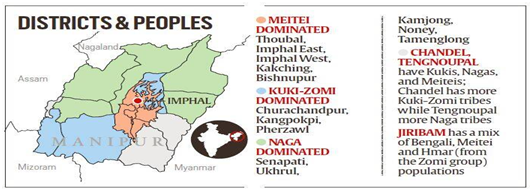Why in News?
- With the violence continuing in Manipur for more than a month now, the Centre announced a peace committee to facilitate the peace-making process among various ethnic groups in the state.
- According to the Ministry of Home Affairs (MHA), the committee will include representatives of different ethnic groups like the Kukis and Meiteis.
What’s in Today’s Article?
- Major Communities Residing in Manipur
- What's Behind the Violence in Manipur?
- Why does the Meitei Community want ST Status?
- Why are Tribal groups against ST Status for Meiteis?
- Is this the only Reason for the Conflict?
- News Summary Regarding Peace Committee
Major Communities Residing in Manipur:
- The State is like a football stadium with the Imphal Valley representing the playfield at the centre and the surrounding hills the galleries.
- The valley, which comprises about 10% of Manipur’s landmass, is dominated by the non-tribal Meitei. This area yields 40 of the State’s 60 MLAs.
- The hills comprising 90% of the geographical area is inhabited by more than 35% recognised tribes. This area sends only 20 MLAs to the Assembly.

What's Behind the Violence in Manipur?
- The recent protests were triggered by the Manipur HC’s direction to the State to pursue a 10-year-old recommendation to grant Scheduled Tribe (ST) status to the non-tribal Meitei community.
- The Court’s order has brought the historical tensions between the valley-dwelling Meitei community and the state’s hill tribes to a boil.
Why does the Meitei Community want ST Status?
- The demand for ST status arose from the need to preserve the community, and save the ancestral land, tradition, culture and language of the Meiteis.
- As per the arguments forwarded by the community in the court:
- The community has been victimised without any constitutional safeguards to date and have been gradually marginalised in their ancestral land.
- Constituting 59% of the total population of Manipur in 1951 has now been reduced to 44% as per 2011 Census data.
Why are Tribal groups against ST Status for Meiteis?
- The tribal groups say the Meiteis have a demographic and political advantage besides being more advanced academically and in other aspects.
- The Manipuri language of the Meiteis is included in the Eighth Schedule of the Constitution.
- Sections of the Meitei community - which is predominantly Hindu - are already classified under Scheduled Castes (SC) or Other Backward Classes (OBC).
- Hence, the claim that Meiteis need ST status to protect their culture and identity is self-defeating.
- They feel the ST status to the Meiteis would lead to loss of job opportunities and allow them to acquire land in the hills and push the tribals out.
Is this the only Reason for the Conflict?
- Pro-government groups in Manipur claim that some tribal groups with vested interests are trying to scuttle the CM’s crusade against drugs.
- The anti-drug drive began with destroying poppy fields and the theory that illegal settlers from Myanmar are behind clearing forests and government lands to grow opium and cannabis.
- These settlers are ethnically related to the Kuki-Zomi people of Manipur.
- The first violent protest was against the eviction of the residents of a Kuki village allegedly in violation of Article 371C, which confers some administrative autonomy to the tribal-dominated hill areas of Manipur.
News Summary Regarding Peace Committee:
- Government of India has constituted a Peace Committee in Manipur under the chairpersonship of the Governor, Manipur
- The peace committee was part of a series of measures, including a judicial probe panel, announced by the Union Home Minister at the end of his four-day visit to Manipur.
- The members of the committee include the CM, a few ministers in the state government, MP, MLAs and leaders from different political parties.
- The committee includes former civil servants, educationists, litterateurs, artists, social workers and representatives of different ethnic groups.
- The mandate of the committee will be to strengthen social cohesiveness, mutual understanding and facilitate cordial communication between various ethnic groups.










